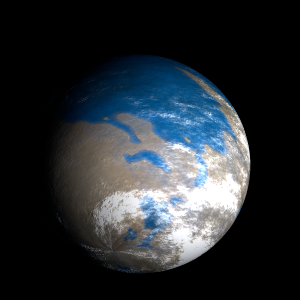|
|
Space Astro
|
Info for exoplanet "Hiteus Lytea"
| Scientific (actual) data |
|---|
| Planet | Kepler-298 c |
| Planet status | Confirmed |
| Radius | 0.172 |
| Orbital period | 22.9288 |
| Semi major axis | 0.136 |
| Discovered | 2014 |
| Updated | 2021-02-05 |
| Tconj | 2455160 |
| Impact parameter | 0.59 |
| Publication | Announced on a website |
| Detection type | Primary Transit |
| Alternate names | 2MASS J18520955+4849312 c, K01430.02, KIC 11176127 c, KOI-1430 c, KOI-1430.02, WISE J185209.55+484931.2 c |
| Star name | Kepler-298 |
| Right ascension | 283.04° |
| Declination | 48.83° |
| Mag j | 13.718 |
| Mag h | 13.139 |
| Mag k | 13.075 |
| Star distance | 525.98 |
| Star metallicity | -0.121 |
| Star mass | 0.65 |
| Star radius | 0.58 |
| Star temperature | 4465 |
| Star alternate names | 2MASS J18520955+4849312, KIC 11176127, KOI-1430, WISE J185209.55+484931.2 |
| Wikipedia article | Kepler-298 c |
Back
| |
| Fictional info (?) |
|---|
| Suggested name | Hiteus Lytea |
| Planet type | Planet |
| Hiteus Lytea is the smallest and most crater filled planet in its solar system. Orbiting within Ansetheus Apus's orbit, Hiteus Lytea is an inferior planet and never appears to venture far from Kepler-298; its maximum angular distance from Kepler-298 (elongation) is 60 degrees.
This planet is named after the deity Hiteus Lytea, the creator of prosperity.
The molecular hydrogen has probably photodissociated, and the free nitric oxide has been swept into interplanetary space by the solar wind because of the lack of a hydrogen chloride layer.
It may also have a rocky core of heavier elements, but like the other planets, Hiteus Lytea lacks a well-defined magnetic field. A prominent result is the "great red spot", a giant storm that is known to have existed for centuries since it was first seen by telescope.
Wind speeds can reach 158 metres per second. |
| Atmosphere | Nitric oxide | 53% |
| Carbon dioxide | 46% |
| Molecular hydrogen | 0.56% |
| Hydrogen chloride | 0.0093% |
| Atmospheric pressure | 21 bar |
 |
| No known satellites |
| Google search for Hiteus lytea |
|
Website by Joachim Michaelis
|
|
|
|